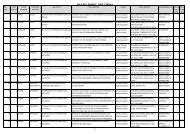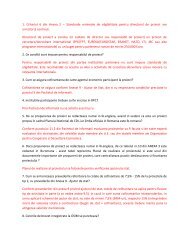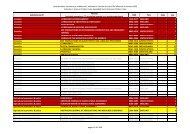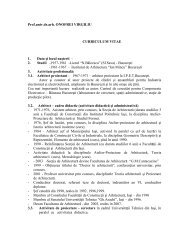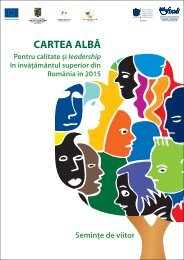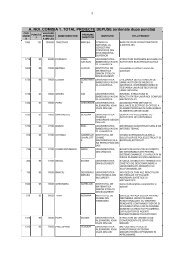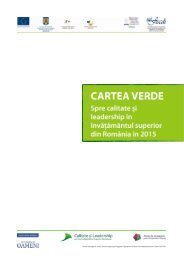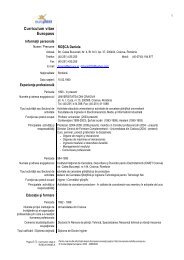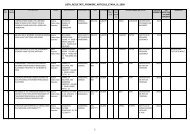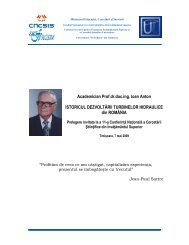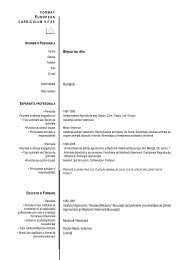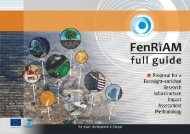Modul de formare-Managementul resurselor financiare - uefiscdi
Modul de formare-Managementul resurselor financiare - uefiscdi
Modul de formare-Managementul resurselor financiare - uefiscdi
- No tags were found...
You also want an ePaper? Increase the reach of your titles
YUMPU automatically turns print PDFs into web optimized ePapers that Google loves.
The research in Danish universities is financed in the form of grants. In addition to the basic<br />
allowance, the institutions can compete for additional funding, based on projects submitted to<br />
the Danish Research Council and Danish Research Foundations. This is a dual system of<br />
financing: both from the government grants and research contracts.<br />
The basic research grant is awar<strong>de</strong>d to the institutions un<strong>de</strong>r a global form. It has a maximum<br />
limit and should not exceed one third of total funding for education and research. In addition,<br />
5% of basic research funding is redistributed: 2.5% on a quantitative parameters basis (the<br />
number of active stu<strong>de</strong>nts, the number of postgraduate stu<strong>de</strong>nts and the value of the research<br />
contracts) and 2.5% on qualitative criteria 10 .<br />
The Danish Ministry of Education has found that a funding system based on outputs faces<br />
problems with the quality. As such, the Ministry has established (since 1992) an assessment<br />
centre: The Danish Evaluation Institute. By conducting regular evaluations of educational<br />
programs this centre improves and maintains the quality of the higher education.<br />
Many Danish universities apply the same funding principle in the internal allocation of funds<br />
too. The internal application of the principle of funding means that a <strong>de</strong>partment with low<br />
performance of the stu<strong>de</strong>nts (e.g. several stu<strong>de</strong>nts who have not passed the exams) will have<br />
allocated fewer funds.<br />
1.3.4. The financing of the public higher education institutions from Australia<br />
Since 1974 the Fe<strong>de</strong>ral Government is responsible for public funding of the higher education.<br />
Higher Education Funding Act (1988) allows the allocation of the grants for higher education<br />
institutions for teaching activities, capital and research. The manner of grants distribution to<br />
institutions is published by the Ministry for Education, Employment, Workplace Relations and<br />
Social Inclusion in the triennial funding report (ma<strong>de</strong> once every 3 years), which is usually<br />
ma<strong>de</strong> in December, each year.<br />
Thus, the main source of funding for higher education (fe<strong>de</strong>ral state operational grants) inclu<strong>de</strong>s<br />
components for education and research. It cannot be ma<strong>de</strong> a clear distinction between teaching<br />
and research components.<br />
The operational grants are distributed according to a normative allocation mo<strong>de</strong>l, called The<br />
Relative Funding Mo<strong>de</strong>l 11 . This mo<strong>de</strong>l was introduced in 1991 to establish an equal distribution<br />
of funds among the institutions of higher education. In coming years, the institutions funding<br />
was based on negotiations between the institutions and ministry. The number of places for the<br />
public fun<strong>de</strong>d stu<strong>de</strong>nts has occupied a central position in negotiations. As a basis for the<br />
bilateral negotiations, the institutions must offer annually the educational profile. During the<br />
<strong>de</strong>bate on the annual educational profiles between the Ministry and the higher education<br />
institutions, an assessment of the higher education institutions for the proposed allocation of<br />
public funds is ma<strong>de</strong>.<br />
The operational grants are <strong>de</strong>termined on the basis of total state-fun<strong>de</strong>d places in one year,<br />
taking into account all the disciplines. The institutions predict a minimum number of<br />
stu<strong>de</strong>nts. Additionally, the educational profiles quotas inclu<strong>de</strong> a residual number of stu<strong>de</strong>nts<br />
(postgraduate studies equivalent), the quotas for new registered ones and a margin of potential<br />
changes in the stu<strong>de</strong>nts’ number.<br />
10 Maassen P. (2003), Mo<strong>de</strong>ls of Finanncing Higher Education in Europe, Center for Higher Education Policy<br />
Studies, pg. 26, also available on-line at: www.cheps.org/radstfjarmMo<strong>de</strong>lsofFinancingHigher.pdf , accessed on<br />
12.02.2006.<br />
11 Kaiser F., Beverwijk J., Cremonini L. ş.a. (2006), Issues in Higher Education Policy 2005: An Update on<br />
Higher Education Policy Issues in 2005 in 10 Western Countries, CHEPS, pg. 4-17, also available on-line at:<br />
www.minocw.nl/documenten/beleidsgerichtestudies121.pdf, accessed on:07.08.2006<br />
11



